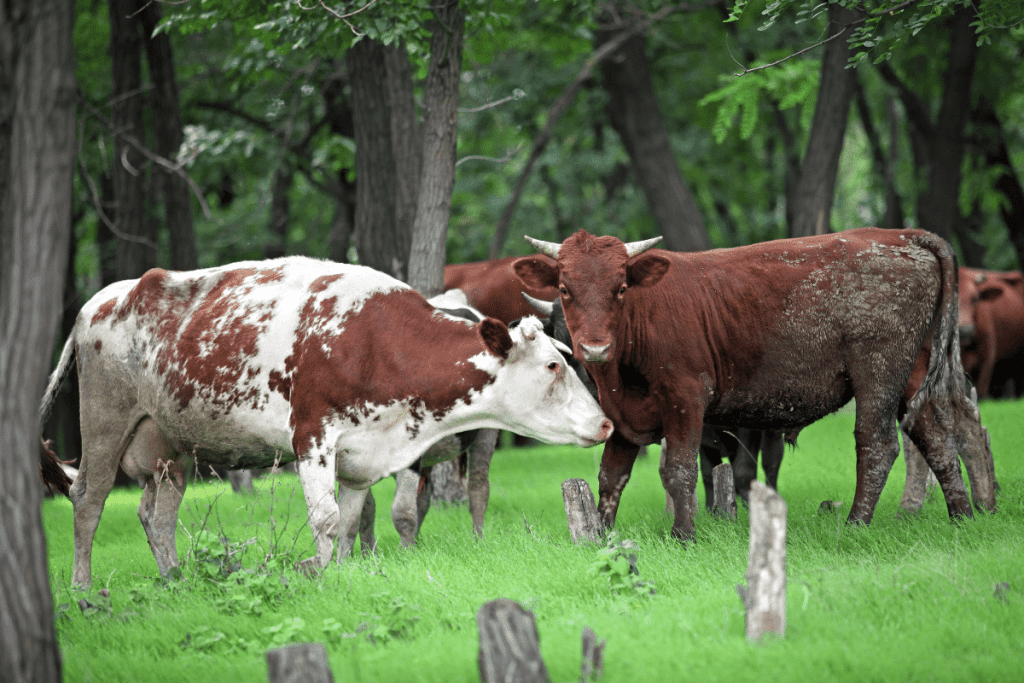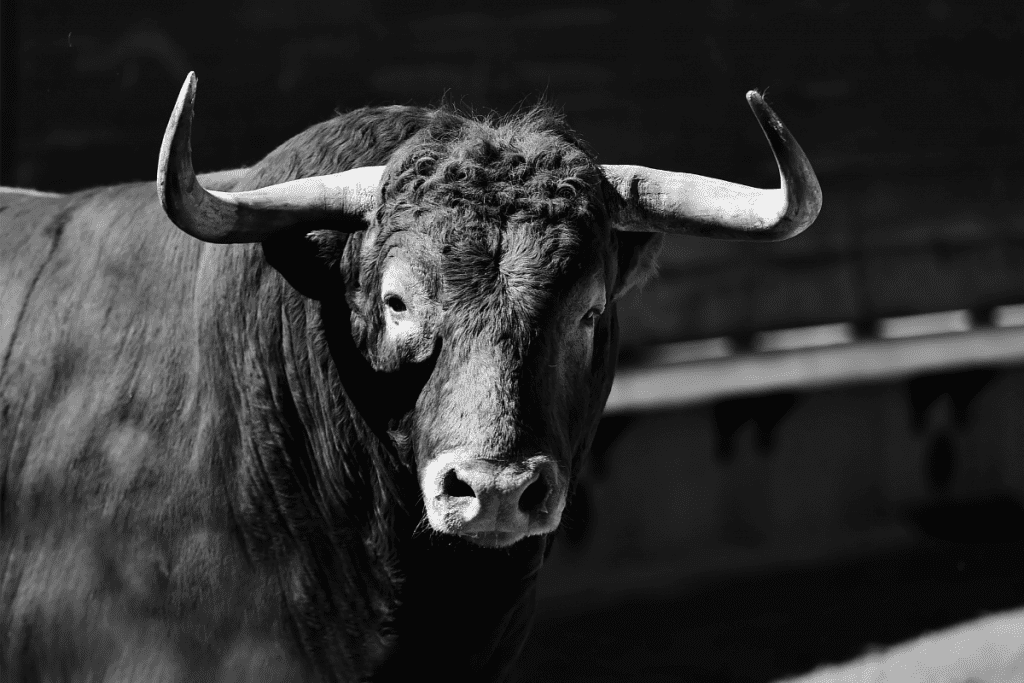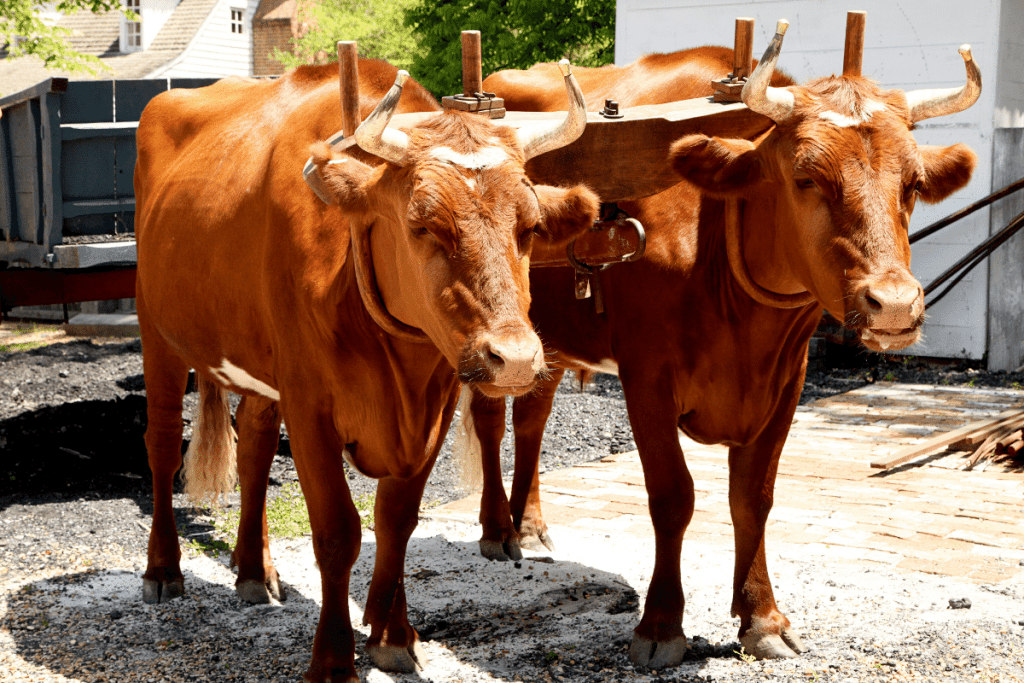Cows, oxen, steer, and bulls refer to fully grown bovines or cattle.
However, the labeling of each distinguishes gender, maturity, and their role on the farm.
A mature female who has had at least one calf is a cow. A mature male who has not been castrated is a bull. Mature males who have been castrated and are trained to do work are oxen.
The terminology “boy, girl, woman, and man” reflects the differences in gender and maturity in humans.
Similarly, labeling “cow, ox, or bull” is a simple way to characterize adult cattle while also giving insight into their purpose on the farm.
Keep reading to find interesting facts and differences about cows, bulls, steer, and oxen.

Table of Contents
ToggleDifferences Between Oxen, Cows, And Bulls (Comparison Table)
| Oxen | Cow | Bull |
|---|---|---|
| Male cattle | Adult female cattle | Adult male cattle |
| Castrated, not used to mate | Fertile | Fertile |
| Calm due to castration | Calm due to domestication | Aggressive |
| Larger than bulls | Large but not muscular | Lean and muscular |
| Used for pulling and work on the farm; meat | Used for mating and milking | Used for mating with cows |
Cows
The word, “cow,” is often misused as a blanket term to refer to a single adult bovine.
However, the word refers to a female bovine above the age of 3 with at least one offspring.
Cows can serve many purposes on a farm, including milk production, meat, or breeding.
Cows are smaller and less muscular than their male counterparts.
The udder is a unique feature of cows, which provides milk for dairy farmers and newborn calves.
A female bovine that hasn’t had any calves is called a heifer.
Heifers are typically raised for meat and other byproducts.
Today, many cows have been selectively bred to encompass certain traits and serve a unique purpose on the farm, such as dairy farming.
Specific breed types are deemed “beef cattle breeds” and “dairy cattle breeds.”
Dairy Cattle
Although all cows can produce milk, some breeds are significantly better are producing large quantities of milk.
Such breeds of cattle are referred to as “Dairy Cattle.”
Like humans, the biological purpose of milk production in cows is to feed their offspring.
Cows don’t begin producing milk until they’ve had at least one calf and must give birth to one calf per year to continue producing milk.
Cows will produce milk for 10 months out of every year after birth.
The most common breeds of cattle used for dairy production are the Holstein cow and the Jersey cow.
Other breeds commonly used for dairy farming include the following:
- Brown Swiss
- Guernsey
- Ayrshire
- Milking Shorthorn
Fun fact: Cows produce about 90% of the world’s dairy and milk!
Holstein Cattle
Due to their high yield and productivity,
Holsteins are responsible for supplying a majority of the global milk supply. (9 out of every 10 cows used for dairy production are Holsteins!)
Mature Holsteins weigh about 1500 and produce over 23,000 pounds of milk annually, or 9 gallons every day.
Some of the most productive Holsteins have recorded over 70,000 pounds of milk per year!
Bulls

A non-castrated adult male bovine is referred to as a bull.
These animals are stronger, more muscular, and much more aggressive due to the amount of testosterone in their body.
Spot a bull by the hump on its shoulders and thick, muscular neck.
Bulls are extremely combative and dangerous and harder to handle than cows or steers.
Due to their temperament, most males are castrated as calves unless they’re used for reproduction.
Bulls are primarily used for breeding, one of the most important roles on the farm.
Breeders typically have one bull to every 20-30 cows or heifers.
Experts recommend a 60-90 day “breeding season,” where the bull can roam and mate with the females.
Having a defined breeding season allows for better herd management.
Additionally, most bulls used for breeding undergo a BSE or a Bull Soundness Examination.
This exam determines their fitness for breeding and helps ensure strong, healthy offspring.
Understandably, bulls are much more expensive than cows, heifers, or steers.
In addition to breeding, bulls are also used in some sports, such as bullfighting and bull riding.
Bullfighting
Bullfighting is a unique spectacle where a matador fights a bull.
Typically, the matador’s goal is to subdue or kill the bull, and the matador must follow a set of rules or guidelines.
The ritualistic event varies across cultures but is hailed as an art form or cultural event in most areas where it is practiced.
Although bullfighting is illegal in many countries, the sport serves as an important cultural event and is most notably still practiced in Spain and Portugal.
Other areas which still allow bullfighting include:
- Mexico
- Southern France
- Peru
- Colombia
- Ecuador
- Venezuela
Bull Riding
Bull riding is another controversial sport, where the rider attempts to stay mounted on a bucking bull for as long as possible.
In American bull riding, the rider must stay on the bull with only one hand for at least 8 seconds to even receive a score.
The rodeo sport first started in Texas and California and has been deemed “the most dangerous 8 seconds in sports.”
Bull riding exists in many places outside of the U.S., including:
- Canada
- Mexico
- Costa Rica
- Belize
- Honduras
- Australia
- New Zealand
The Professional Bull Riders association was formed in 1992 and hosts over 300 televised events across the globe annually.
Further reading: Can You Ride Cows? Is It Like Riding a Horse?
Steers
A steer is a castrated, adult male bovine.
Because steers aren’t used for breeding, they’re typically used for meat and other byproducts.
While we typically think of a hamburger or steak when we think of cattle, these animals are used for much more than just meat.
Other byproducts produced using beef cattle include:
- Leather
- Pharmaceuticals
- Glue
- Gelatins
- Insulin
Beef Cattle
There are over 70 breeds recognized as beef cattle breeds today.
Some of the most popular beef cattle breeds in the United States include:
- Black Angus
- Red Angus
- Charolais
- Hereford
- Simmental
Because cows and bulls are typically used for breeding or dairy farming, most beef cattle are heifers or steers.
Beef cattle are raised to produce high-quality meat with a specific ratio of muscle to fat.
For this reason, beef cattle are fed a specific diet and are encouraged to graze and walk, which leads to a more muscular animal and leaner meat.
Did you know only 40% of the animal is used for meat production?
The remaining 60% is used for byproducts.
For example, candies such as gummy bears and marshmallows use gelatin, a byproduct of beef cattle.
Fun fact: One cowhide can produce up to 20 footballs!
Oxen

An ox is a steer that is trained and used for labor.
Often referred to as draft animals or bullocks, oxen are more docile, safer, and easier to train than bulls.
These hearty mammals are used for hauling carts, pulling wagons, plowing, and other strenuous farm labor.
Oxen typically work in pairs and are tethered together using a wooden beam called a yoke.
While any bovine breed can make a good ox, farmers typically choose dairy breeds for their temperament and other characteristics.
While some farmers opt for workhorses, oxen are a much better choice for manual labor for a few reasons.
Oxen aren’t spooked as easily as horses, which means they’re less likely to be frightened and abandon their task.
Additionally, oxen can pull heavier loads and are usually cheaper than horses.
Innovation and modern technology have eliminated many roles of the ox.
However, oxen are still used on some small farms in the U.S. and developing countries worldwide.
About Cattle
Cattle, also known as bovines, belong to Bos Taurus and are large domesticated cloven-hooved mammals.
Humans have used these hefty mammals for centuries, and it’s believed that cattle were first domesticated 10,000 years ago.
Cattle are herbivores, meaning they don’t eat meat.
Read more about the difference between cows and cattle.
Their diet typically consists of grass, hay, grains, and other plants.
As herd animals, cattle are social creatures and don’t like to be alone.
Herd animals stay together in close groups or clusters and follow a dominant group leader.
Cattle aren’t fully grown until the age of 4, and young cattle are always referred to as calves regardless of their sex.
Because cattle are prey animals, they have unique senses which enable them to detect predators and approaching threats.
For example, cattle have excellent peripheral vision and can see 300° degrees of range without moving their heads.
This is referred to as panoramic vision.
However, cattle can’t see well straight on, as their eyes are located on the side of their head.
In addition to having excellent vision, cattle also have a remarkable sense of smell and detect odors up to 5 miles away.
Fun Fact: Did you know most cattle, both male and female, are born with horns?
Find out more interesting facts about cattle’s horns in this article.
How useful was this post?
Click on a star to rate it!
We are sorry that this post was not useful for you!
Let us improve this post!
Tell us how we can improve this post?
